On July 8th, Cleantech Group delivered a webinar, Clarity Through Chaos, revisiting the predictions we made at the beginning of the year regarding what is expected to grow, flow (progress at a general pace with nuance), and slow (face headwinds) in 2025. We took stock of how the barometer has shifted in just six short months, and where we see the needle moving over the next six, and beyond.
Contrary to expectations of a major drop-off, investments in the first half of this year are generally commensurate with the trend seen last year, particularly in terms of technology area breakdown, with a concentration in Energy & Power. The U.S. has not experienced a major drop-off in investments either.
However, the high-level view doesn’t tell the whole story, and there are significant differences between 2025 and previous years happening under the surface.
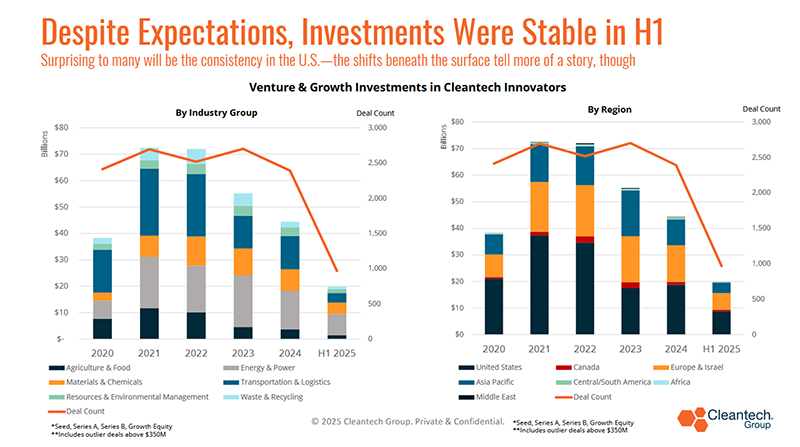
In the U.S., the top 15 investment areas show a strong concentration around themes of energy security and the AI revolution. These two areas very-much-so dovetail into each other, for example, fusion and fission technologies support the development of data centers and address concerns around energy security and independence. There is also significant activity in data center and compute efficiency.
In Europe, there’s some focus on data centers and future energy sources; the concentration is not as pronounced as in the U.S., with Europe’s investment landscape being more widespread. The slight drop in European numbers is not a surprise, and something we’re describing as “transatlantic pain.” Europe is clearly facing macroeconomic uncertainty, interest rate volatility, and trade tariffs, which are impacting the investment mood. Investors and companies are largely adopting a “wait and see” approach, holding off on investment decisions until there is more clarity on interest rates, trade flows, and tariffs.
Both the U.S. and Europe have seen a drop-off in investments in electric mobility and hydrogen from 2024 to 2025, at least for now.
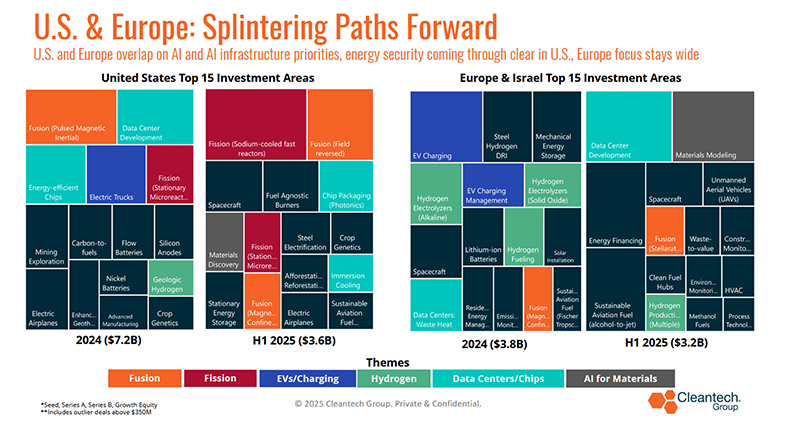
Challenges in Raising New Money
It’s currently a challenge to raise new money for various reasons, including institutional investors (LPs) keeping cash liquid due to uncertainty, making them unwilling to commit to new funds. Uncertainty around exit opportunities or possible IPOs means that funds cannot liquidate, and as a result, LPs are more reticent to reallocate capital.
However, investments only ever tell part of the story. Real projects and manufacturing are often the strongest bellwethers of market readiness and receptivity toward clean technologies. It is real projects and manufacturing that are presenting the strongest challenges right now.
Project Cancellations and Bankruptcies
The past 6-8 months have seen a spate of project cancellations and bankruptcies, particularly in the U.S. This trend is not confined to one space but is seen across hydrogen, solar, battery manufacturing, and green steel. In the U.S., large-scale manufacturing and projects began to face economic realities at the beginning of the year, particularly as it’s harder to execute a commercial facility for the first time compared to merely raising funds for demonstrations and pilots. That was even before policy signals turned negative for many of these areas. And, while there’s a healthy amount of first-of-a-kind projects being stood up, these were likely in motion a year or more ago, suggesting a potential lagging effect to come.
While Europe doesn’t have the same level of policy uncertainty as the U.S., it continues to face very high energy prices compared to the U.S. For some European project cancellations, high energy costs are a key explanatory factor, particularly for first-of-a-kind projects where it’s hard to make commercial sense. This is especially critical for sectors like green steel and hydrogen, where it’s simply difficult for Europe to compete due to these very high costs.
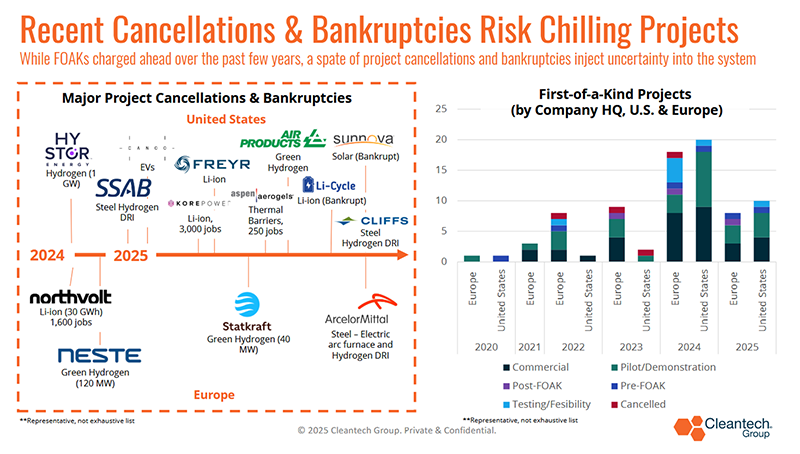
The Northvolt project cancellations and subsequent bankruptcy sent “cold signals” and “rippling effects” to the European finance sector regarding the prospects of scaling new manufacturing mega-projects. There is a palpable risk averseness among investors compared to a year or two ago. The market is more discerning toward metrics around commercial viability and technology readiness levels (TRL) of projects today. Due to budgetary constraints, there will likely be fewer European grants as well, with a greater focus on de-risking tools such as public guarantees, counter-guarantees, and blended finance to maximize the efficiency of every Euro spent.
Non-Equity Financing
When looking at non-equity financing, the U.S. drop-off from 2024 to 2025 doesn’t seem as significant, but it’s important to note that over $11B of these figures are attributable to one major deal: Crusoe Energy’s $11.6B deal with OpenAI’s Stargate project.
In the U.S., bankable themes in this space are largely centered around AI, which has a clear demand pull irrespective of policy, while Europe’s focus areas are more widespread, though the data centers trend is also present, e.g., GreenScale’s late ’24 loan to add 300MW of a planned 1GW data center capacity across Europe.
Beyond different sectoral focuses, Europe has a slightly less diverse capital stack for non-dilutive finance compared to the U.S. with approximately 80% of non-dilutive finance in Europe still provided by banks, which are highly regulated in terms of the risk they can undertake. Banks often have a different, potentially more conservative, appetite for technology risk, making them more reticent to lend in an environment of high uncertainty. That’s compounded by a learning curve on the financial side regarding supporting newer, less familiar technologies.
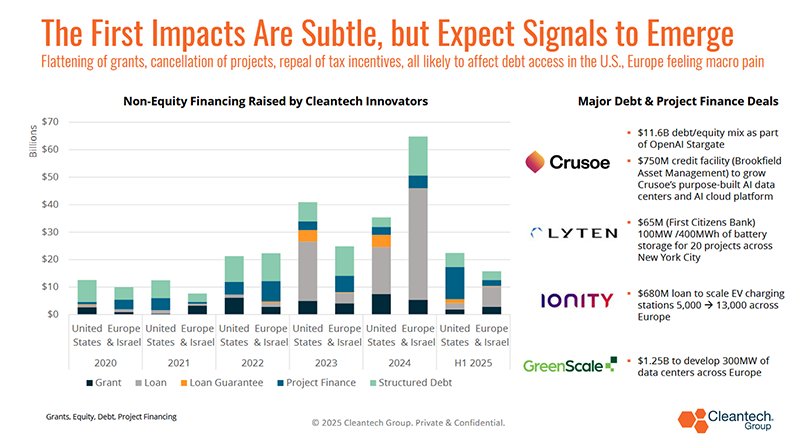
Back in January, I delivered our expectations for 2025 with Cleantech Group’s CEO, Richard Youngman, through 3 lenses: Grow, Flow, and Slow.
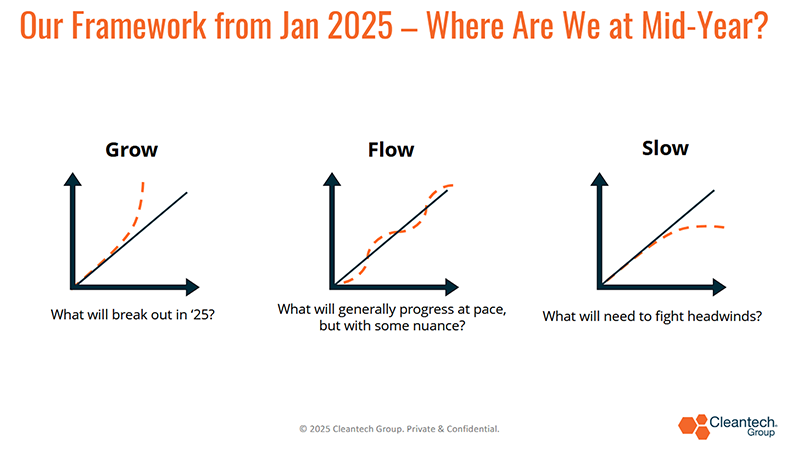
The Grow Category: What is Still Accelerating
We Expect Continued Acceleration Along the AI Infrastructure Continuum
Of little surprise is the demand for cleantech innovation stimulated by the AI revolution. This isn’t just about data centers; it’s a profound pull-through effect across the entire cleantech landscape. From new sources of baseload power to advanced materials and semiconductors, and infrastructure development around power collocation, AI is driving demand.
We’re seeing intense activity in areas like cooling and power management within data centers, as well as services designed to make compute less energy intensive. While we predicted more exits along this continuum, the sheer activity and underlying demand are undeniable. Nevertheless, holding ourselves accountable for predictions: we have only seen one exit along this continuum this year, that of Terrestrial Energy, in the form of a May ’25 SPAC announcement.
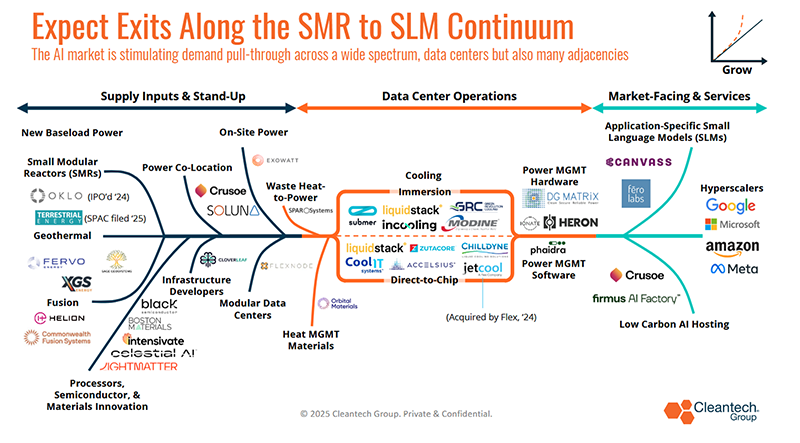
Fusion has gone from feeling distant to surprisingly near-term, with investments remaining significant and geographically diverse, extending beyond the U.S. and Europe to Asia-Pacific. More impressively, we’re seeing commercial traction, such as the June ’25 500MW PPA between Commonwealth Fusion and Google, and an earlier one between Helion and Microsoft. The sheer amount of technical breakthroughs in the past 5 years or so, exemplified by TAE Technologies’ April plasma breakthrough, has increased comfort with the technology as commercial offtakers and investors become more familiar with fusion milestones. The diversity of reactor types (over a dozen) receiving attention and funding also indicates growing familiarity and comfort with the longer development timelines.
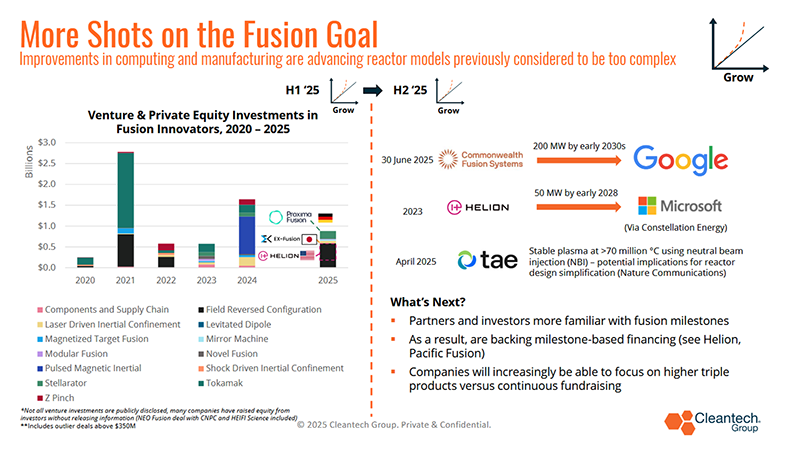
Nuclear fission had a very strong Q2, significantly boosted by the TerraPower deal which saw participation from Nvidia and Bill Gates. This space enjoys a rare active exit environment (e.g., Terrestrial Energy’s SPAC filing) and strong administrative support in the U.S. We expect to see more localized regulations and tailored approaches to reactor types to ease development. While market forces are intensifying the urgency, lingering questions remain about who will finance construction, as traditional PPAs are unlikely to account for all variables in permitting and constructing a fission reactor.
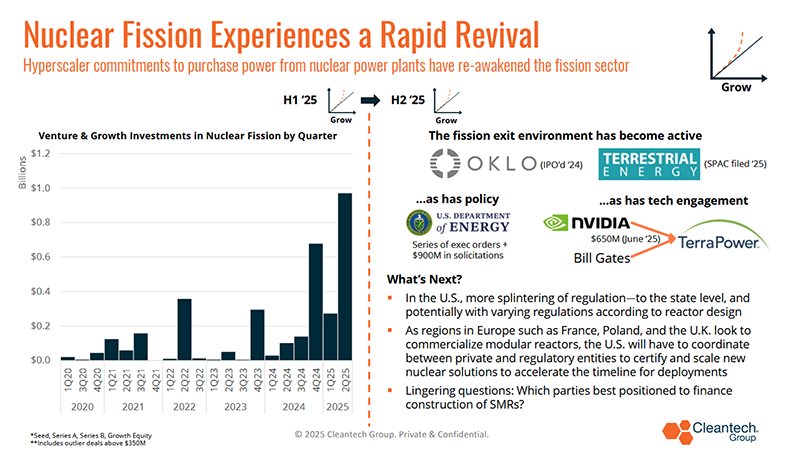
Compute efficiency is, in our opinion, one of the most overlooked bright spots in cleantech right now. The diversity of innovation across the value chain is fascinating, from semiconductor manufacturing (e.g., Forge Nano) to hardware (e.g., Intensivate, Lightmatter, Celestial AI) and even heat transfer materials at the nanotech level (e.g., NovoLinc, Boston Materials, and 3D Architech).
Given the increasing energy intensity of chips, everything along this value chain will be critical. Speed to manufacturing and scale is paramount here – demand for these products is near-term, and winners will need to be able to work with conventional manufacturing approaches and equipment. This is also a fiercely contested global space, with significant innovation coming from Asia-Pacific, China (e.g., Semi-Tech), South Korea (e.g., DeepX), and Singapore (e.g., Silicon Box).
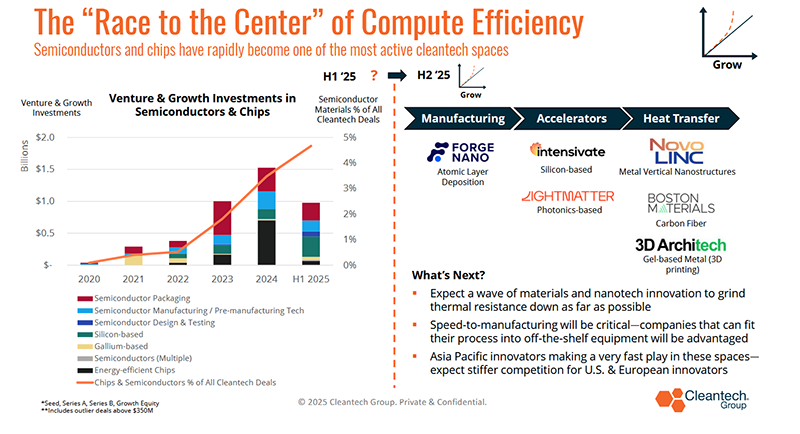
Critical Minerals
Critical materials are foundational to all clean technologies, and the demand-supply gap is incredibly intense. The IEA reported in May on significant future demand, projecting lithium demand to be almost five times what’s currently needed by 2040, and a 30% increase in copper demand. The mining sector alone requires $500-$800B in investment to meet these goals. The current supply chain dynamics are complex, with mines holding power, processors facing shortages, and smelters shutting down globally.
While navigating China is a factor, it’s not solely a trade problem, nor will it be solely a trade solution. Innovators like Summit Nanotech (direct lithium extraction), Maverick Metals (copper, rare earths, lithium), and Phoenix Tailings (rare earth supply) are making significant progress.
Supply Chain Dynamics: Currently, mining holds power, as processors face shortages of concentrates from mines and are even trading at zero or negative fees, willing to pay for supply. This is a global issue, not just a China trade problem, with smelters worldwide shutting down due to short supply. Crucially, with mining permits taking 5-10 years, it’s “now or never” for new innovations and mines. The recently passed One Big Beautiful Bill (OBBB) removes the permanent 45X advanced manufacturing tax credit for critical minerals production, instead phasing it out after 2033.
While the Foreign Entity of Concern (FEOC) restrictions put forward in the OBBB will nudge producers to engage onshore extraction and refining, the shorter timeline on tax credit availability potentially dulls this nudge. This will undoubtedly raise costs for U.S. domestic producers of critical minerals, who likely modeled mine lifetime with these credits in mind.
Even so, there is observable drive by demand owners to secure materials locally (see the recent MP Materials deals with The Pentagon and Apple), indicating a willingness to pay price premiums for onshore materials – a crucial window of opportunity for innovators. We also believe that, given the new FEOC restrictions, there is a potential second wind coming for e-waste recycling as a critical source of materials in the U.S.
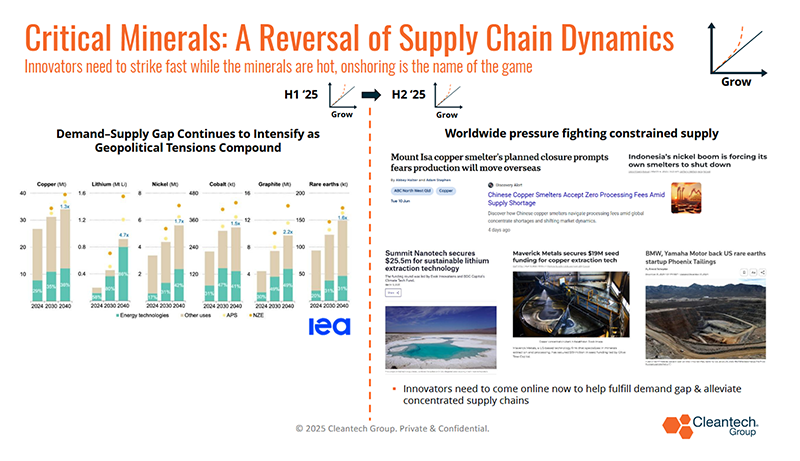
Enhanced Geothermal
While investments tell a positive story, the real excitement lies in the commercial traction and technical breakthroughs. We’ve seen more promising commercial agreements including Fervo Energy securing off-take financing for a half-gigawatt facility in Utah and XGS partnering with Meta. Further, the pull-through effect from the AI revolution and data center power needs has put technology into the field faster than expected, generating technical breakthroughs at a rapid rate.
Take Fervo’s results over the past year or so, recently demonstrating drilling depths over 15,000 and accessing temperatures of 520°F, the Cape Station project has reported multiple holes >8,000 ft. vertical, connected via a 5,000 ft. lateral hole to create a large “wine rack” formation. These developments are important, because they validate some key hypotheses around technology transfer from other industries – in Fervo’s case, horizontal drilling from natural gas fracking.
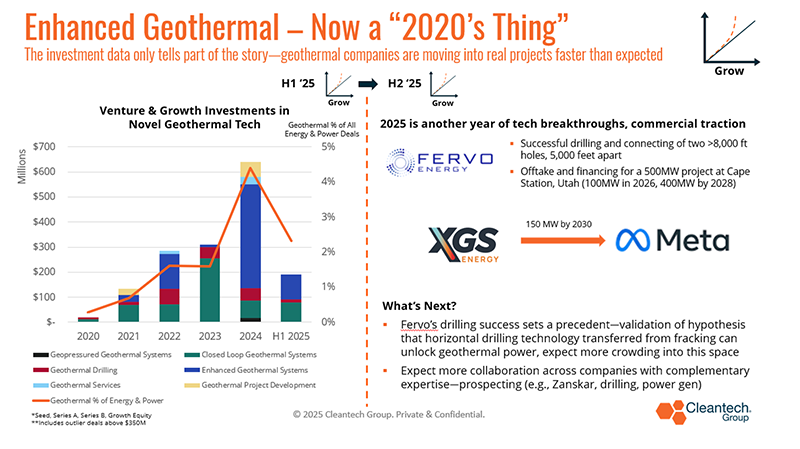
Wildfire Resilience
Unfortunately, this “grow” category is driven by necessity. Investments are on track to outstrip last year’s figures, and more importantly, technologies are demonstrating real-world impact. Companies like Pano AI and OroraTech are publishing case studies of fires they’ve helped mitigate – now able to point to demonstrable results of damage avoided. Interestingly, large tech players like Google are entering the space with initiatives like Google Firesat, a 50-satellite constellation (the first of which launched in March) for early wildfire identification – competitive pressure on innovators is likely to increase as AI incumbents continue to begin to see a receptive market.
We expect the proliferation of early identification technologies, boosted by recent jumps in AI capabilities to reduce costs of early response. Nevertheless, the risk imposed by wildfires (already estimated by MunichRe to have totaled $136B in 2015-2024, with only $80B insured) is enough to require more adoption of tech, and tech that plays at different stages of fires. We predict this to smooth adoption costs for demand owners and provide a boost for direct intervention technologies like prescribed burns (e.g., Burnbot) and autonomous suppression (e.g., Rain).
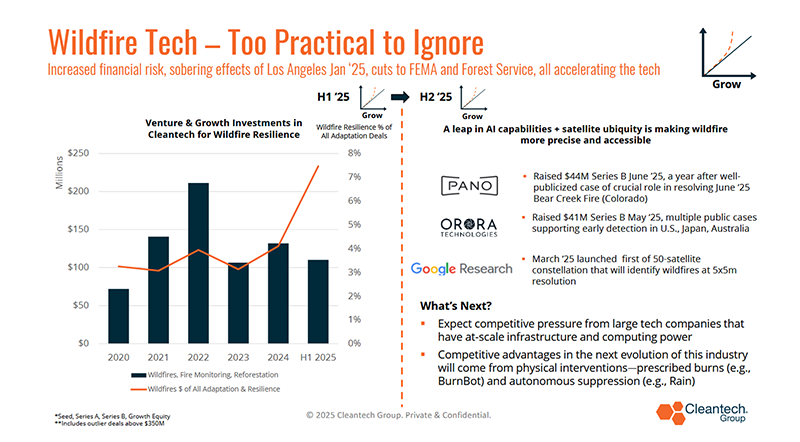
The Flow Category – What Do We Expect to Continue at Pace?
Power Resilience
Likely with some controversy, we’ve moved this from “grow” to “flow”, mostly due to a blunted pull-through effect on long-duration energy storage (LDES) from renewables in the U.S. and more modest expectations for industrial decarbonization projects off a spate of Office of Clean Energy Demonstration project cancellations. While the LDES drop-off is easily observed in the equity investment figures, there is indeed some regional nuance.
Unlike the U.S., Europe does not have the local access to oil and gas required to achieve energy independence with fossil fuels, and as a result, energy security and renewables deployment are synonymous in some European circles, and conversations around practical changes such as permitting reforms for renewables are seen as energy security measures. As a result, we expect LDES to continue deployment in Europe to extend the effectiveness of renewables. Indeed, commercial developments (like Energy Dome’s with Engie in Italy) and FOAK financing arrangements (like Malta’s with BBVA for 14MWhe in Spain) are signals that LDES is slowly edging into the mainstream in Europe.
The nuances are different around grid technologies, which are experiencing what is likely to be their strongest investment year yet in 2025. Generational electricity demand from the AI revolution, the need to manage unseen capacity on grids, and surgically manage power flows at sites of high economic value (data centers), is spurning interest across the grid tech spectrum. Technologies that have remained relatively static for decades are all of a sudden being re-invented and attracting fast interest.
In the past year, we’ve seen a wave of Seed and Series A rounds toward new types of transformers: DG Matrix ($20M), Heron Power ($38M), and Ionate ($17M). There is also palpable enthusiasm around high-temperature superconductors (HTS), both in their wiring incarnations (e.g., Veir) and in HTS components (e.g., Suprema Tape). Watch the HTS components space closely – HTS has promise not only for grid tech, but also for fusion reactors and energy-efficient chips. In a future where fusion becomes possible at a commercial scale, a component manufacturing race will ensue, with HTS components becoming a linchpin technology for developing cost advantages.
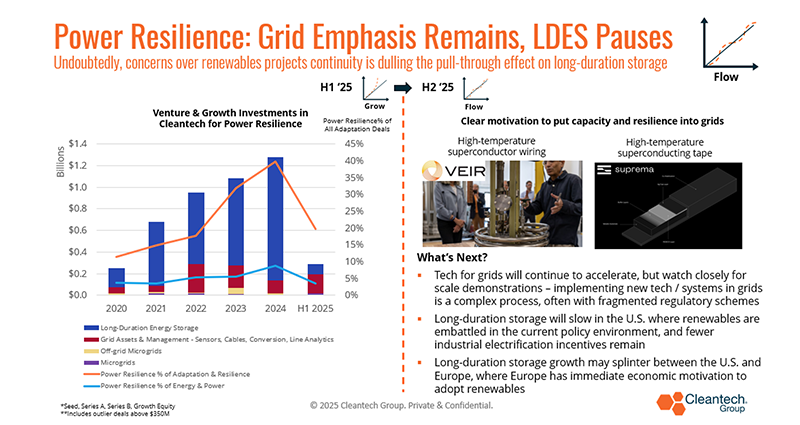
Non-Lithium Storage
This category remains in “flow.” While investments tell a generally positive story, there are ups and downs, exemplified by Bedrock Materials returning money to investors when they foresaw a likelihood that their sodium-ion batteries wouldn’t compete with lithium-ion at current lithium prices. A much-circulated paper in Nature earlier this year highlighted the energy density gains that sodium-ion would need to make in order to compete with lithium-ion.
However, the OBBB’s significant foreign entity of concern content thresholds (60% non-FEOC in 2026, 85% by 2029) could provide a second wind for sodium-ion and associated technologies, as it will be challenging to produce compliant lithium batteries domestically if materials largely originate from China. Even with that potential opening, expect continued competition from China in sodium-ion, with incumbents like CATL and innovative start-ups like Zhongna Energy active in the space.
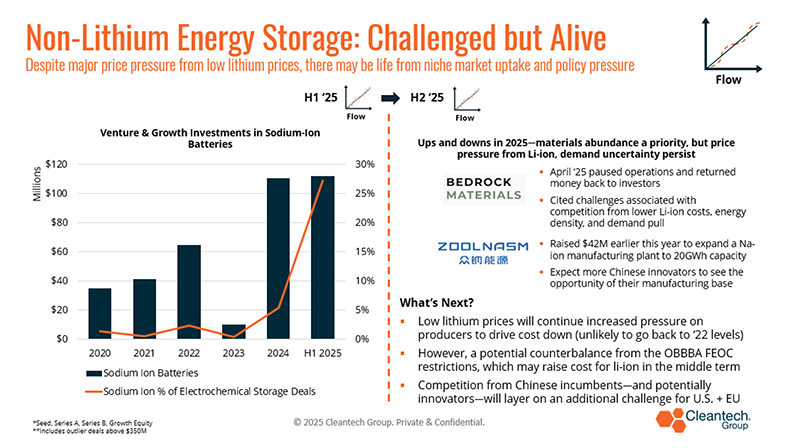
“Systems Change” AI
While we have observed the impact of AI on cleantech – not just software, but hardware innovation, too – over the past few years, a trend we didn’t have categorized in January that we do now is that of “systems change” AI. Systems change AI are solutions that we see as overhauling the entire way that certain systems work, as opposed to solutions to specific problems or subsets.
Examples include:
- ThinkLabs: Create end-to-end grid modeling and management using physics-informed models, essentially providing “tens of thousands of electrical engineers” to diagnose and resolve issues in the grid. This will be an especially important solution as utilities need to map improvements to the grid to accommodate generational demand growth at a time when grid liabilities due to natural disaster risk are increasing.
_ - Utilities and ISOs are already seeing the value in generative AI for grid management and outage prevention; see the recent collaboration between CAISO and OATI’s Genie product. We expect more of this in the coming months.
_ - Lila Sciences: Leverage AI for materials formulation and direct interventions with robotics to create self-driving factories for battery materials and hydrogen electrolyzers. This innovation represents more than just a change to the science of materials discovery, but a step change in the iteration process to see which new materials work and don’t work in the real world, and much faster.
_ - Inari: Uses AI to guide crop scientists to precisely understand and manipulate plant DNA. Instead of traditional, often time-consuming breeding methods, they can use AI-driven analysis of extensive data sets to pinpoint exactly which edits and edit types will have the most positive impacts at specific locations within a crop’s DNA structure.
_ - As we have put forward in recent months – AI will have a massive impact on the development of crop inputs as a result of R&D efficiency gains at a time when changing weather patterns are closing the windows of opportunity to adjust crop treatments but opening the door to innovations like biostimulants to complement contemporary approaches.
With that said, not every AI cleantech company will succeed. We see a clear differentiator for companies offering industry-specific tools with proprietary data, rather than those relying on public data or LLMs, which may become commoditized. AI integration in R&D, manufacturing, and in-situ interventions (like mining) will provide significant competitive advantages. Another way to say it – AI will require a data uniqueness advantage, deep tech integration, or both, to continue standing out within the cleantech theme.
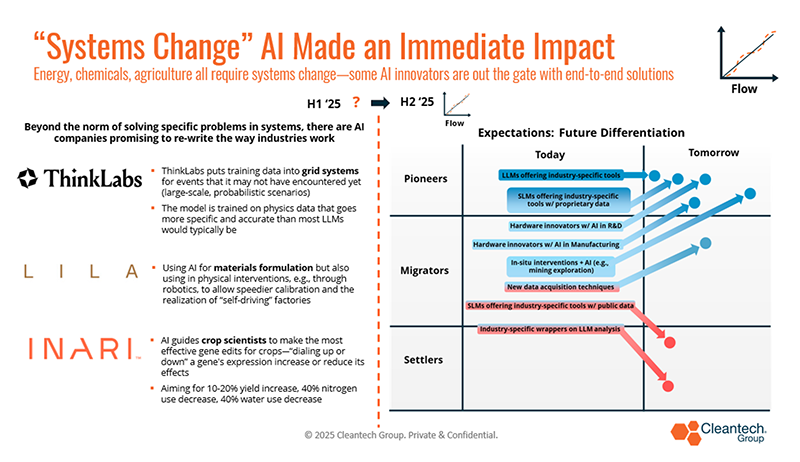
The Slow Category – What Will Continue to Face Headwinds?
Hydrogen
This remains firmly in our “slow” category. The fundamental dynamic hasn’t changed: adoption markets outside of traditional uses like certain chemicals and ammonia-based fertilizers have not picked up. We’ve seen numerous cancellations of hydrogen-based green steel projects in recent months and the additional hypotheses like distance transport have not borne out.
The OBBB’s accelerated phase-out of the 45V hydrogen tax credit (from 2033 to 2028), while not eliminating it, will make it harder for new hydrogen production technologies to get off the ground in time to take advantage. There’s a regional nuance here, with some hydrogen innovators shifting focus to Asia-Pacific, particularly Japan and Korea, where significant government goals and adoption momentum exist. An example is Amogy’s July 15th announcement that it completed $23M of its recent $80M fundraise round to focus on bringing ammonia-to-power (maritime, stationary storage) to APAC countries including Japan, Korea, and Singapore.
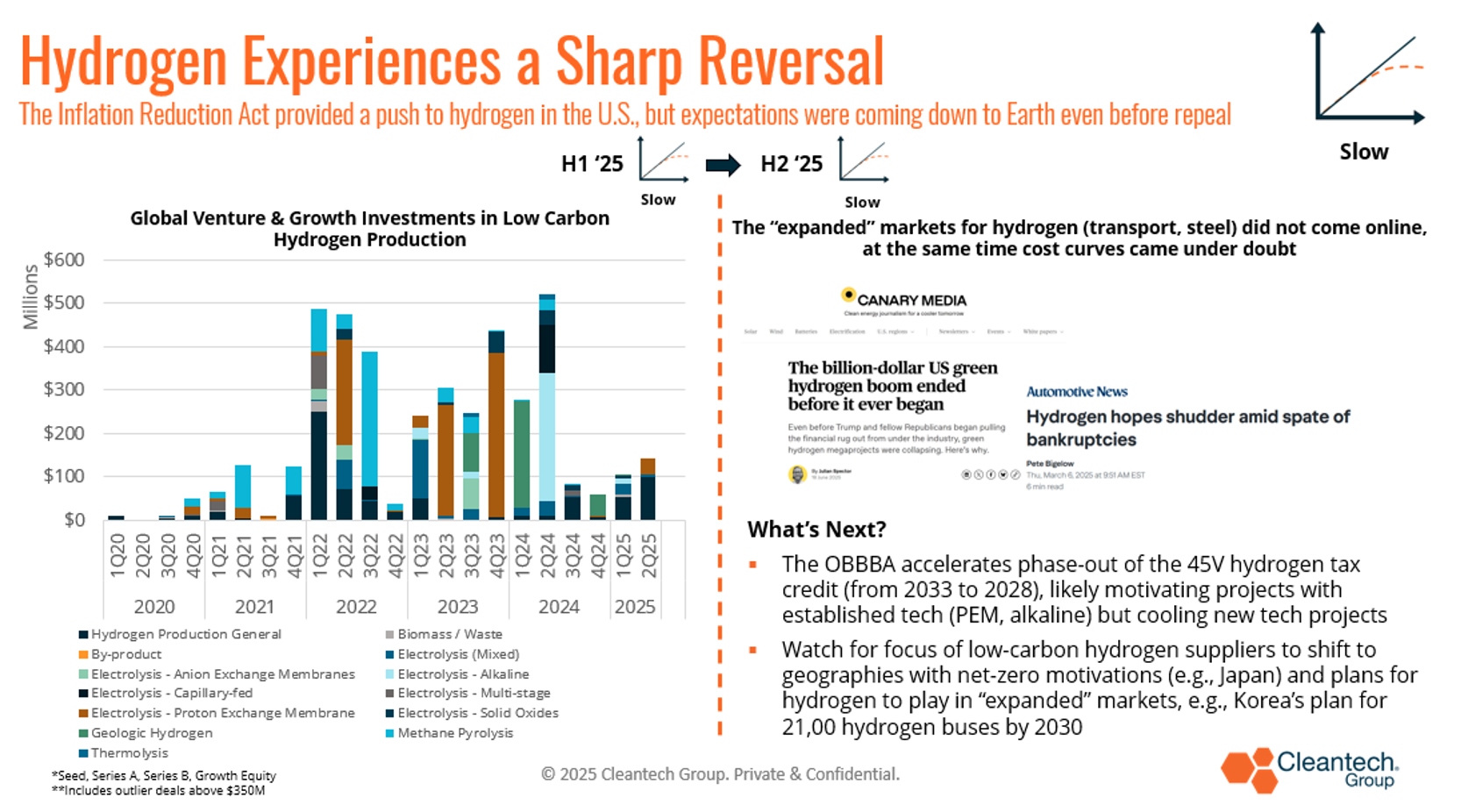
Battery Manufacturing and Materials
In the U.S., the accelerated phase-out of electric vehicle (EV) tax credits in September 2025 will dull (but not eliminate) demand for EVs, and thus slow the market pull-through for EV batteries. As put forward in our year-ahead outlook in January, major global project cancellations (e.g., Kore Power and FREYR Battery) and bankruptcies (e.g., Northvolt) have brought into sharp focus the challenges of vertically-integrated battery manufacturing in the U.S. and Europe.
However, some innovators are finding creative solutions, such as Ascend Elements leveraging European opportunities or Redwood Energy repurposing second-life batteries for data center backup storage. Moreover, the FEOC restrictions for battery manufacturing referenced earlier are likely to challenge producers of batteries that are sourcing Li-ion materials and components from China (the majority). An interesting byproduct of this development may be a second wind to battery recyclers in the U.S. This may seem counterintuitive, given the recent Li-Cycle bankruptcy, but with the new FEOC restrictions set to apply to manufacturing facilities established post 2025, materials recyclers that can efficiently access feedstock may be in position to provide “FEOC-free” battery materials.
Carbon Removals
Carbon removals remain in the “slow” category despite decent investment and commercial traction. The trust issues we discussed at the outset of the year around voluntary carbon market’s “phantom credits” and related controversies still linger, and at a time when corporate commitments are receding. The pool of buyers for credits and acquirers of companies remains highly concentrated in big tech and oil and gas, and there are only so many of these buyers to go around.
Microsoft’s recent deal with Chestnut and Oxy Low Carbon Ventures’ recent acquisition of Holocene (note that Occidental Petroleum also acquired Carbon Engineering in 2023) are evidence of where momentum comes from in this space. The OBBB, while allowing tax credit transferability, has tightened restrictions on foreign entities buying credits, further shrinking the market.
However, there is now more potential for the utilization sections of the carbon capture, utilization, and storage (CCUS) to grow as the OBBB now places CCUS on a similar footing for tax credits, encouraging co-benefits like carbon-to-value and carbon-to-fuels. On the sustainable aviation fuels (SAF) front, the OBBB does reduce the section 45Z production tax credit amount ($1.75/gallon to $1/gallon) but extends credits by two years through 2029. So while we expect the carbon removals market to remain challenged, we expect SAFs that use carbon as an input (e.g., e-SAF) to continue developing at current momentum. See progress on projects like Infinium’s Project Roadrunner as indicators.

Our H2 2025 “Bingo Card”
We divide this section into “Safe Bets,” “Coin Flips,” and “Wild Cards.” In each area, my colleagues and I will give you our bold predictions.
Safe Bets – Things We Feel are Likely to Occur

Anthony DeOrsey, Research Manager
-
- The Foreign Entity of Concern (FOEC) policy is expected to tighten, making manufacturing and building more challenging due to policy, tariffs, and rising electricity prices.
- There will also be more regulatory changes at the local/state level to ease nuclear (fission) development, tailored to reactor types, to attract economic activity driven by data centers and AI.
 Diana Rasner, Group Lead, Material & Chemicals and Waste & Recycling
Diana Rasner, Group Lead, Material & Chemicals and Waste & Recycling
-
- AI-driven data center PPAs (power purchase agreements) will scale from megawatts to gigawatts.
- To address critical minerals supply chain issues, there will be more partnerships developing across geographies and companies, rather than a single domestic supply dominance, due to the complexity and long timelines for mining and manufacturing.
 Luis Rebelo, Policy Manager, Cleantech for Europe & Cleantech for Iberia
Luis Rebelo, Policy Manager, Cleantech for Europe & Cleantech for Iberia
-
- Expect cleantech to merge with defense tech in Europe, creating dual-use applications, driven by institutional capital deployment in defense and increased public budgets.
_ - Grid security and resilience will also be a safe bet, as recent blackouts in Spain, Portugal, the Czech Republic, and Italy highlight the grid’s pressure, leading to more focus on innovative solutions and long duration energy storage.
- Expect cleantech to merge with defense tech in Europe, creating dual-use applications, driven by institutional capital deployment in defense and increased public budgets.
Coin Flips – Things We think are Possible, But Could Go Either Way in 2H 2025

-
-
A geothermal IPO is likely sooner than expected, driven by sustained demand from the AI revolution and the priority of energy security/independence, combined with commercial traction and technical breakthroughs.
-
Cleantech and healthcare overlaps will become more apparent, with pharmaceutical innovators touting energy use reduction in their products, potentially leading them to be recognized as cleantech innovators.
-
Food security will accelerate into mainstream conversation, given its close ties to energy and national security, with increased focus on crop genetics.
-
-
- A less heated debate around nuclear energy in Europe is possible, driven by the EU’s need for low-carbon energy for the AI race and the potential use of excess nuclear capacity for pink hydrogen.
-
Water security will return high on Europe’s agenda due to droughts, dry years, and rainfall shortages, with AI and data centers adding to the pressure, especially in Southern Europe.
Wild Cards – Things We Think are Further Afield, But Could Surprise Us in H2

-
-
AI for cleantech may face another wave of “creative destruction”; while not a bubble, the rapidly accelerating capabilities of models mean that companies relying on LLMs or public data will be challenged by newer, more powerful innovators.
-
A geoengineering breakout is possible, particularly where co-benefits exist, especially when overlapping with the water and food security arguments, i.e., models that evolve from climate arguments to resource security arguments.
-
-
- A major oil and gas or service company might engage in M&A with small-/mid-tier mining companies, leveraging their drilling and resource extraction expertise (e.g., ExxonMobil in lithium extraction).
-
Biogas could become the “next hydrogen wave,” offering energy resilience and supply, but with its own set of challenges depending on regional advantages.
-
-
The role of geothermal energy in Europe could significantly expand due to high energy costs and the need for diverse electrification solutions, especially with a new EU geothermal action plan announced.
-
There could also be positive surprises in industrial electrification announcements in Europe, building on PPAs and behind-the-meter renewables/batteries, to counter the stagnation in Europe’s electrification rate.
-
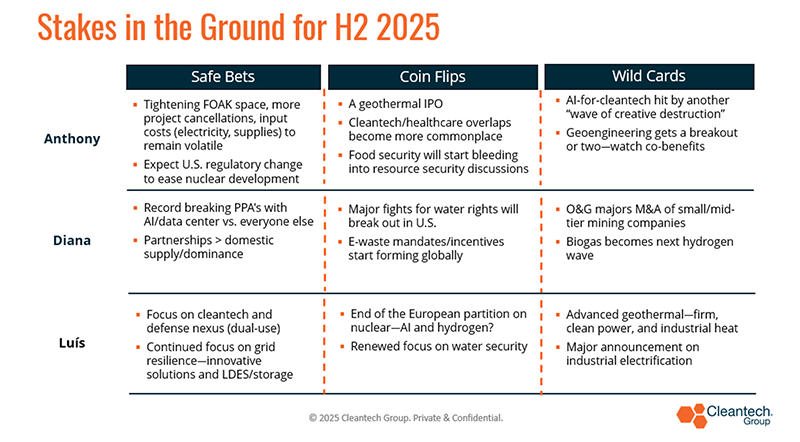
How did we do? What might we be missing? And more importantly, what are you seeing out there?


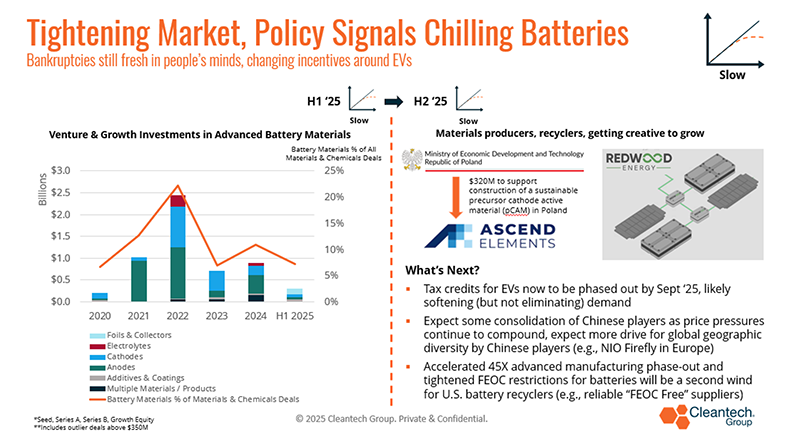
 Diana Rasner, Group Lead, Material & Chemicals and Waste & Recycling
Diana Rasner, Group Lead, Material & Chemicals and Waste & Recycling Luis Rebelo, Policy Manager, Cleantech for Europe & Cleantech for Iberia
Luis Rebelo, Policy Manager, Cleantech for Europe & Cleantech for Iberia